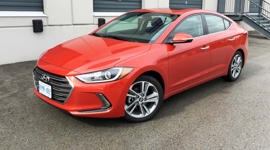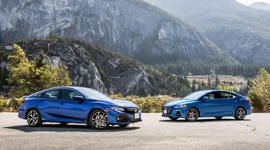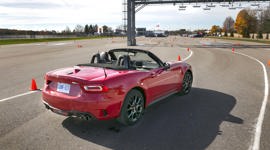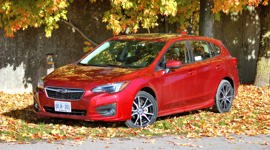For the Canadian introduction of its redesigned 2017 Elantra, Hyundai scheduled a day of driving in and around Victoria, BC. The morning's route took us past picturesque oceanside parks and along twisting forest-lined backroads. Then after lunch we stopped at a suburban grocery store where corporate reps loaded each Elantra's capacious trunk with bagfuls of groceries. It was, they told us, a little something in lieu of the usual tchotchke or gizmo handed out to journalists as a memento of the event. We weren't expected to keep the groceries, mind you, but rather to drive them to Victoria's Our Place Society, an inner-city mission serving the city's homeless and vulnerable. There we were rewarded with the gift of giving, delivering the food ourselves to the mission's kitchen. It was a well-conceived and generous gesture, and to Hyundai's credit that appears to be the approach the company has taken with the Elantra itself, too.
"We were given carte blanche to put together Canadian-tailored content," Marshall remarked. "So these aren't simply U.S. trims carried over to Canada."
The sixth-generation Elantra is a fraction bigger than the previous car – 20mm longer, 5mm taller and wider – providing interior room that ranks as midsize despite the car's positioning in the compact segment. This keeps the Elantra competitive with the recently upsized Honda Civic and Toyota Corolla, and ahead of the Ford Focus and Mazda3. The exterior style bears a distinct family resemblance to the Sonata, with smoothly sculpted sides, a steeply sloping rear roofline, and an on-trend hexagonal grille flanked by LED accent lights. There are LED accent taillights too, and the overall effect is good looking if a tad conservative.
Hyundai has been knocked in the past for a sub-par ride quality compared to its chief rivals, and during a pre-drive presentation product manager Eric Marshall explained how the engineers have worked to improve things by reconfiguring the rear torsion axle's suspension geometry, adding rubber isolation mounts for the front subframe, and stiffening the car's structure through increased use of high-strength steel and structural adhesives.
The new Elantra uses 53 percent high-strength steel versus 21 percent in the old car, and to illustrate the real-world effect of this, PR manager Chad Heard put on simple demonstration, laying two identical-looking sheets of steel – one mild and one high-strength – between a pair cinder blocks, then standing on each of them. The mild steel sheet bent and collapsed to the floor, while the high-strength sheet held strong. Point taken, and the demo lent credence to Hyundai's assurance that the new car should score top ratings in IIHS and NHTSA crash tests.
Pricing and packaging for the new Elantra has been a mystery since the car's Los Angeles debut, and Marshall shed some light with a brief walk-through of the lineup, although final pricing has so far been determined only for the base L trim, which will start at $15,999. This is a $200 increase compared to the equivalent 2016 model and we can expect similarly modest increases across the range, which currently tops out at $25,849. "We know we need to remain competitive with Toyota and Honda," Marshall hinted.
The L trim gets a manual transmission and 15-inch steel wheels, with standard features including power locks and windows, remote keyless entry, tilt/telescope steering wheel, multifunction trip computer, six-speaker AM/FM/MP3 audio with USB and auxiliary inputs, seven airbags (including driver's knee airbag), electronic stability and traction control, ABS brakes, projector headlights and, this being Canada, even heated front seats. "We were given carte blanche to put together Canadian-tailored content," Marshall remarked. "So these aren't simply U.S. trims carried over to Canada." Moving up from from the base trim will be an LE model that adds high-demand amenities including manual air conditioning, automatic transmission, Bluetooth connectivity and steering-wheel mounted audio controls.
Hyundai's high-volume trims are the GL and GLS. The GL adds 16-inch alloys, cruise control, heated leather steering wheel, automatic headlights, LED daytime running lights, a seven-inch colour infotainment touchscreen with Android Auto, backup camera with dynamic guidelines, blind spot detection with cross-traffic alert, satellite radio, exterior mirror signal repeaters, and a 3.5-inch colour driver information display. The GLS gets all that plus bigger 17-inch alloys, power sunroof, rear disc brakes, heated rear seats, proximity key with pushbutton start, door pocket lighting, hands-free trunk and dual automatic climate control.
At the upper end the Limited gets perforated leather upholstery, eight-way power driver's seat with seat/mirror memory, eight-speaker Infinity audio system, bigger eight-inch touchscreen and 4.3-inch driver information screen, LED rear combination lamps, rear parking assist system, Homelink, and mirror-mounted compass. A new Ultimate trim adds a full suite of advanced driver assistance technologies including autonomous emergency braking with pedestrian detection, lane keeping assist, adaptive cruise control and adaptive HID headlights.
I tried out a Fiery Red Elantra Limited and an Electric Blue GLS. Regardless of trim level, the interior features a soft-topped dash, with good-looking rigid plastics elsewhere. Door panel inserts are upholstered to match the seating, and the armrests and console tops are soft-surfaced. A band of painted metallic-look trim sweeps along the door panels and across the dash, providing a sense of width and a natural transition point for two-toned colour schemes. The fit and finish is excellent, and the spring-loaded lid for the electronics cubby at the base of the centre stack glides smoothly open and shut like something from a luxury car. Inside the cubby are two 12V outlets, an auxiliary audio input and a USB port.
I found the leather-upholstered eight-way power driver's seat in the Limited trim car to be properly comfortable, but without a squab angle adjustment the cloth-upholstered seat in the GLS was merely okay. Regardless of how you adjust the seat there's no getting around the somewhat obstructive A-pillars (they're thick and swoop well forward), but rearward visibility was surprisingly good given the steeply sloping roofline. The back seat was certainly nice and spacious, with plenty of legroom and decent headroom for my 5'11" frame. One slightly puzzling feature is that the Limited trim's seat memory can only be set with the transmission in Park, so you can't save on-the-road tweaks as you make them.
With only a few hours of drive time I wasn't able to get fully familiar with the infotainment systems in the two cars, so I had a couple moments of frustration with the menu systems (they're slightly different between trims), but that said it was easy enough to get phones connected, and the interface was intuitive enough that we were able to quickly and easily display Google Maps (using Android Auto) in the GLS, in lieu of built-in navigation.
The two audio systems (six-speaker in the GLS and eight-speaker Infinity in the Limited) were both decent-sounding if perhaps a little unremarkable. The Infiniti system does add a bit more presence and bass. What I did find disappointing was that I couldn't access my latest playlist from my USB thumb drive in either car – apparently the systems don't recognize iTunes m4a files, although product manager Eric Marshall said he'd look into getting that rectified.
Power for all Canadian trims comes from a new DOHC 16-valve 2.0L Atkinson-cycle engine with continuously variable valve timing, based on the existing Nu engine architecture (Canada won't be getting the 1.4L turbocharged Eco model). Transmission options include either a six-speed manual (in L trim only) or a new six-speed automatic that Hyundai says is 4.4 percent more efficient than the previous automatic. Standard front wheel air curtains, full underbody cover and an exceptionally low 0.27 coefficient of drag further aid highway efficiency.
The new Nu engine features multi-port injection and fuel-saving technologies including electronically-controlled thermostat, high energy ignition coils, and piston cooling jets. Estimated power ratings are 147 hp and 132 lb-ft of torque, pending final fuel economy certification. Marshall said Hyundai expects the combined rating will be in the low sevens (L/100km), and during our nearly 200 km test drive I saw about 8.3 L/100km in city driving and 7.4 L/100km on the highway, so the estimate seems reasonable. For comparison, the 2016 Elantra GL with the 1.8L engine is rated at 8.8 / 6.4/ 7.7 L/100km (city/hwy/combined).
Official acceleration numbers weren't available at press time, but using autoTRADER.ca's carefully calibrated test instruments (a smartphone stopwatch and the car's own speedometer) we clocked a 0-100 km/h run of just under 10 seconds with two persons on board and a poor-to-middling launch. I'd guess an official rating would land the Elantra in the 9.0 to 9.5 second range (comparable to the outgoing model), but it feels quicker than that around town. The take-home message is that it's plenty powerful enough to keep up with traffic, although the Atkinson cycle engine does get a little busy sounding when pushed hard.
All models with the automatic transmission get a driving mode button that tailors not just the steering weight (as in previous Elantras) but also the throttle mapping and transmission shift points for Eco, Normal or Sport driving. The modes are well-differentiated: Eco makes the car feel a little sluggish off the line, while Sport mode livens up the throttle response, holds gears longer (so you get decent engine braking) and gives some real heft to the steering. Steering feel is muted, but it's adequate in Sport mode.
In addition to the front subframe isolation and rear suspension changes, the 2017 Elantra gets a new electric steering system and new sound deadening measures including rear wheel well liners and thicker front glass. Marshall asked us to pay particular attention to the ride quality and sound levels during our drive, so naturally I sought out every speed bump, frost heave and pothole I could find. The Elantra soaked it all up with the calm of a well-trained butler, and with no hammering at all. On smooth tarmac the interior was admirably hushed, with subdued tire hiss the only notable sound at moderate cruising speeds.
Around corners the Elantra exhibits minimal body lean and maintains its composure even when tossed rapidly from one corner straight into the next. The 225/45R17 Nexen N'Priz AH8 all-season tires fitted to the Limited trim test car weren't the stickiest I've ever tried, but the chassis made good use of the available grip and proved to be reasonably well balanced. Push things hard and you'll eventually get understeer (it's front wheel drive, after all) but the understeer comes on slowly and progressively. Under hard braking I got the ABS working overtime, but the car stopped confidently despite the damp conditions.
Overall the new Elantra definitely has what it takes to continue its battle with Toyota's Corolla and Honda's Civic for not-so-compact sedan supremacy – it's well thought-out, generously proportioned, and offers an impressive array of available equipment. The 2017 Elantra entered production in January 2016 in both Montgomery, Alabama and Ulsan, South Korea, and should be arriving at Canadian dealerships in mid-February.






















































